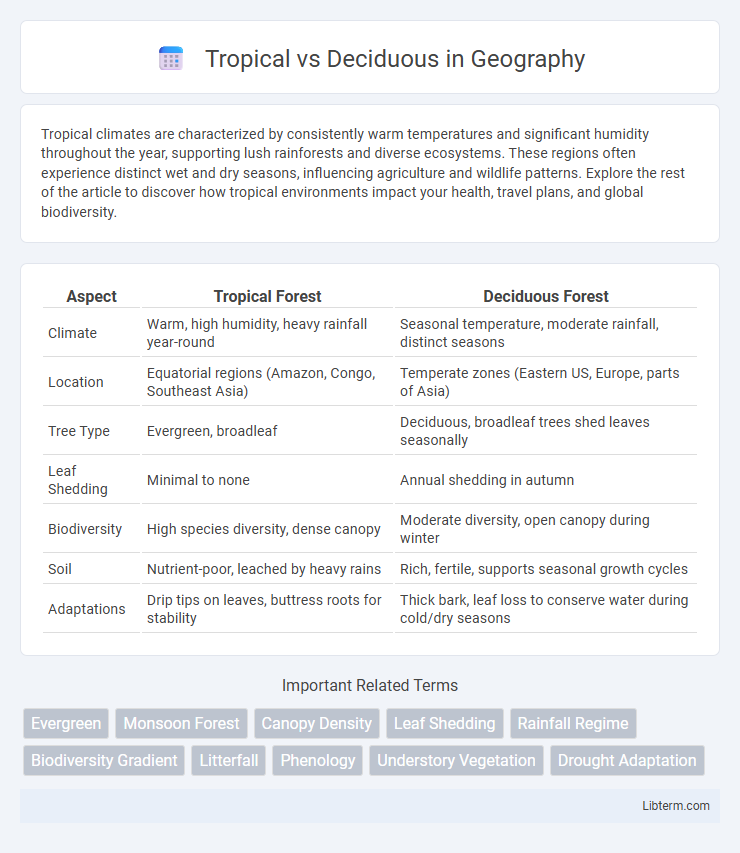Tropical climates are characterized by consistently warm temperatures and significant humidity throughout the year, supporting lush rainforests and diverse ecosystems. These regions often experience distinct wet and dry seasons, influencing agriculture and wildlife patterns. Explore the rest of the article to discover how tropical environments impact your health, travel plans, and global biodiversity.
Table of Comparison
| Aspect | Tropical Forest | Deciduous Forest |
|---|---|---|
| Climate | Warm, high humidity, heavy rainfall year-round | Seasonal temperature, moderate rainfall, distinct seasons |
| Location | Equatorial regions (Amazon, Congo, Southeast Asia) | Temperate zones (Eastern US, Europe, parts of Asia) |
| Tree Type | Evergreen, broadleaf | Deciduous, broadleaf trees shed leaves seasonally |
| Leaf Shedding | Minimal to none | Annual shedding in autumn |
| Biodiversity | High species diversity, dense canopy | Moderate diversity, open canopy during winter |
| Soil | Nutrient-poor, leached by heavy rains | Rich, fertile, supports seasonal growth cycles |
| Adaptations | Drip tips on leaves, buttress roots for stability | Thick bark, leaf loss to conserve water during cold/dry seasons |
Introduction to Tropical and Deciduous Forests
Tropical forests, characterized by high biodiversity and consistent warm temperatures, receive abundant rainfall year-round, supporting dense, evergreen vegetation. Deciduous forests experience distinct seasonal changes, with trees shedding leaves in autumn to conserve water during dry or cold periods, and they host a variety of plant and animal species adapted to these cycles. Both forest types play crucial ecological roles, influencing global carbon cycles and providing habitats for diverse wildlife.
Key Climate Differences
Tropical forests thrive in warm, humid climates with consistent high temperatures ranging from 20degC to 30degC and receive over 2000 mm of annual rainfall, supporting evergreen vegetation year-round. Deciduous forests experience distinct seasonal variations with temperatures fluctuating between -30degC in winter and 30degC in summer, and moderate rainfall typically between 750 to 1500 mm annually, prompting trees to shed leaves to conserve water during dry or cold periods. These climate contrasts drive unique adaptations in flora and fauna, reflecting the fundamental ecological differences between tropical and deciduous forest biomes.
Distinct Vegetation Types
Tropical forests feature dense, evergreen vegetation with high biodiversity, including broadleaf trees, lianas, and epiphytes that thrive in warm, humid climates year-round. Deciduous forests contain trees that shed their leaves seasonally to conserve water during dry or cold periods, comprising species such as oaks, maples, and beeches. These distinct vegetation types reflect adaptations to differing environmental conditions, with tropical forests maintaining continuous canopy cover and deciduous forests exhibiting seasonal foliage changes.
Biodiversity Comparison
Tropical forests host significantly higher biodiversity compared to deciduous forests, with species richness reaching up to 200 tree species per hectare in tropical regions versus fewer than 10 in many temperate deciduous forests. High levels of humidity and stable temperatures in tropical ecosystems foster diverse plant, animal, and microorganism populations, creating complex ecological interactions. Deciduous forests, characterized by seasonal leaf shedding, support a unique but less diverse range of species adapted to fluctuating climates and nutrient cycling patterns.
Seasonal Changes and Adaptations
Tropical forests experience minimal seasonal changes with consistent warm temperatures and high rainfall, promoting evergreen vegetation adapted to year-round growth and nutrient cycling. Deciduous forests undergo distinct seasonal variations, including cold winters and dry periods, leading to leaf shedding as an adaptation to conserve water and energy during unfavorable conditions. These adaptations reflect evolutionary responses to climatic patterns, influencing biodiversity, photosynthetic activity, and ecosystem dynamics in both forest types.
Soil Composition and Fertility
Tropical soils, primarily Oxisols and Ultisols, are typically acidic, nutrient-poor, and heavily weathered due to intense rainfall and leaching, requiring organic matter for fertility. Deciduous forest soils, often Alfisols and Inceptisols, tend to be more fertile with higher levels of organic material, as seasonal leaf litter enriches the soil with nutrients. These differences impact agricultural potential, with tropical soils needing amendments for productivity, while deciduous soils support diverse crop growth more naturally.
Geographic Distribution
Tropical forests are primarily found near the equator within the tropics, covering regions such as the Amazon Basin, Central Africa, and Southeast Asia, where warm temperatures and high rainfall support dense evergreen vegetation. Deciduous forests mainly occur in temperate zones, including parts of North America, Europe, and Asia, characterized by seasonal temperature variations causing trees like oaks and maples to shed leaves during colder months. The distinct geographic distribution of tropical versus deciduous forests reflects adaptation to differing climatic patterns and ecological conditions.
Ecological Roles and Functions
Tropical forests support immense biodiversity, playing a crucial role in carbon sequestration and climate regulation through dense vegetation and year-round photosynthesis. Deciduous forests contribute significantly to nutrient cycling by shedding leaves seasonally, enriching soil fertility and supporting diverse soil organisms. Both forest types provide critical habitats for wildlife, but tropical forests maintain more complex ecosystems due to constant climatic conditions.
Human Impact and Conservation
Tropical forests face intense human impact from logging, agriculture, and urbanization, leading to significant biodiversity loss and disrupted carbon storage. Deciduous forests experience habitat fragmentation and invasive species due to land use changes, threatening native wildlife and ecosystem balance. Conservation efforts prioritize reforestation, sustainable land management, and protected area expansion to mitigate damage and preserve ecosystem functions in both forest types.
Conclusion: Choosing Between Tropical and Deciduous
Choosing between tropical and deciduous plants depends on climate, maintenance preferences, and aesthetic goals. Tropical plants thrive in warm, humid environments and offer lush, year-round greenery, while deciduous plants adapt to seasonal changes, providing dynamic foliage colors and winter dormancy. Understanding these distinctions helps select species that align with environmental conditions and landscape design intentions.
Tropical Infographic

 libterm.com
libterm.com